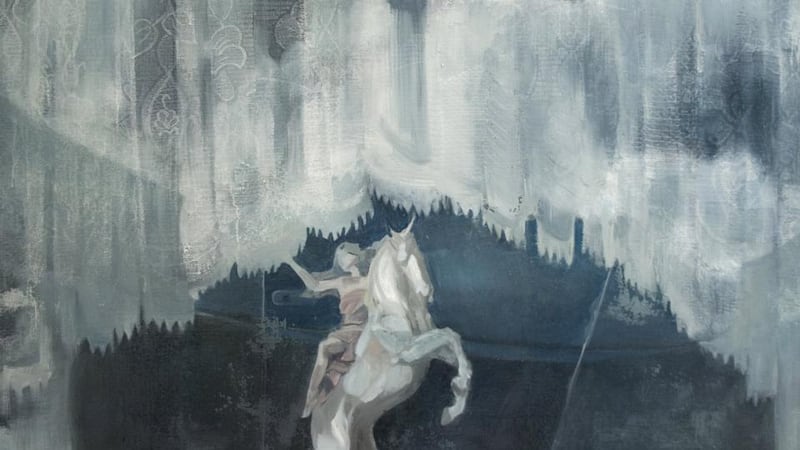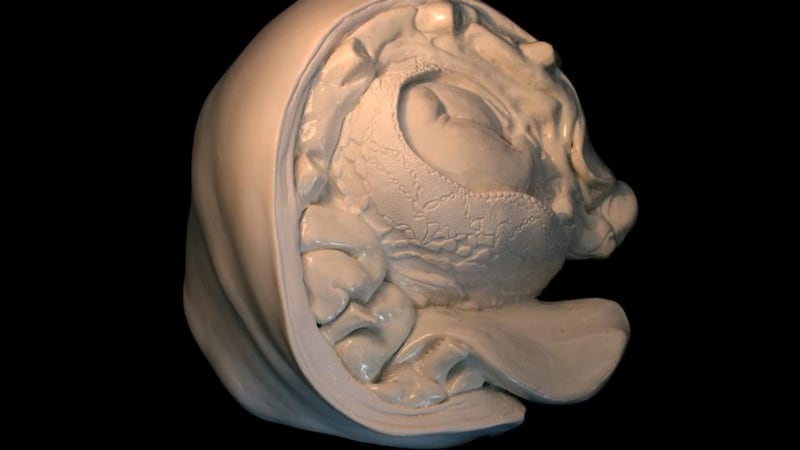Breeding Ground – Vera Klute
Molesworth Gallery, Dublin
★★★★
For an artist whose work is rooted in what might be termed everyday domesticity, Vera Klute slips with surprising ease into nightmarish terrain. Ostensibly her concerns centre on the family and how individuals relate to the world around them. She deals with the experience of motherhood from the point of view of both mother and child, for example, and our experience of relatedness in more general ways.
But she doesn’t take a cosy view of motherhood and family. Time and again we are reminded that although we may idealise ourselves as belonging to a superior, sophisticated species, the peak of civilised society, in reality we are more immersed in and part of natural processes and cycles than we like to imagine. It’s not just nature red in tooth and claw: it’s us in nature, all teeth and claws.


Klute was born in Salzkotten, a small city near Paderborn in Germany but opted to study art in Ireland. Reportedly she was wary of the emphasis on conceptualism in art education at home. Certainly, everything she has done as an artist confirms that she is a maker. Not that she wants for ideas, but they are articulated through the personal, physical, hands-on practice of making things. She went to Dún Laoghaire Institute of Art, Design and Technology and graduated in 2006. The artist Kathy Prendergast once commented that during her time at NCAD she was grateful to the staff for leaving her alone. That surely applies to Klute as well.
No one exactly taught her the formidable range of skills she has mastered. What she needed, and needs, are time and space to devote to learning. Her range is exceptional. Fundamentally, she draws, and in a way drawing underpins her use of painting, photography, collage, video, carving, modelling, construction, tapestry, ceramics and even taxidermy. She seems to delight in figuring out and mastering techniques.
She has been extremely busy in the 10 years since her graduation (for which she showed an impressively accomplished animated film). Allergic as she is to easy options, each of a string of solo shows throughout the country was utterly distinctive and usually entailed learning new technologies and media. She has won several awards, including last year's Hennessy Portrait Award for her small but intense study of Anne Ryder, the mother of a close friend. Coincidentally her portrait of Sr Stanislaus Kennedy, a National Gallery commission, was unveiled last year. Direct and exact, it does not set out to flatter and, as with a good deal of her work, recalls aspects of the new objectivity, the 1920s German art movement that grew in reaction to expressionism.
Intimate bond
In her standout 2014 show at the Lab in Dublin, the warm, intimate bond between mother and children was given a sci-fi makeover in her wax and polystyrene sculptures Growth I and II. In them, the mythic Hydra meets Invasion of the Body Snatchers. Based with uncanny realism on specific portrait subjects, offspring sprout fully formed from a mother's head, suggesting a number of unwholesome ideas such as parasitism and cloning. They anticipated a series of new sculptures in her dense, multifaceted show at the Molesworth Gallery. Flesh & Blood I-IV consist of intricately modelled organic forms in partly glazed porcelain that are both seductively beautiful and unmistakably sinister.
They recall elaborately detailed antique anatomical models in which layers of tissue have been peeled away to reveal a foetus curled within the womb. You quickly realise that is exactly what Klute is showing us, but there is a slippery liveliness to the formative shapes in her sculptures that is disturbing. She is offering a glimpse of living, developing beings rather than instructional museum specimens. In a hallucinatory touch, a cluster of celebratory tulips is incorporated in the body of Flesh & Blood I: the forms of flowers and foetus echo each other, and there's definitely a hint of social rituals to come. There are other indications of life's relentless cycles developing as surely as the foetus is growing.
Klute brings the various meanings of her title into play and draws them back to the simple, harsh reality of flesh and blood. She takes the idea of the physical intimacy between family members and explores it in a number of works.
The motif of holding hands becomes something else in Cluster I and II, as multiple limbs cling and intertwine, making up a kind of needy, composite organism in a slightly creepy way that recalls the mood of Growth.
In Bulk, multiple bodies interlink around a central spine that becomes a kind of (family) tree trunk, an idea echoed in Mass. When she moves from fragmented anatomies to whole people, her gaze is no less forbidding. The multiple family members of The Herd I and II overlap and intermingle so much that they lose any individual coherence. In the long term, Klute reminds us, our social niceties are just part of the set pattern, full of oddness and denial.
In three linked, animated drawings, portraits of herself, her mother and her daughter, she introduces an imaginative dimension, offering a glimpse into the mental lives behind the faces. It’s not a hugely encouraging glimpse. A downbeat interpretation might see each confined to a conceptual orbit that allows little room for manoeuvre.
- Until June 10th, molesworthgallery.com










